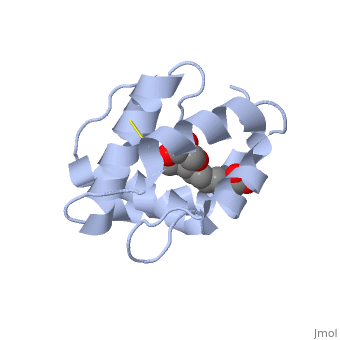Pheromone binding protein
From Proteopedia
(Difference between revisions)
| Line 2: | Line 2: | ||
<StructureSection load='3bfa' size='340' side='right' caption='Pheromone binding protein of ''Apis mellifera'' scene=''> | <StructureSection load='3bfa' size='340' side='right' caption='Pheromone binding protein of ''Apis mellifera'' scene=''> | ||
As the most ancient sense in nature, smell and chemical communication play a major role in successful mating, host and selection and other essential behaviors. | As the most ancient sense in nature, smell and chemical communication play a major role in successful mating, host and selection and other essential behaviors. | ||
| - | + | The detection of volatiles (often a small hydrophobic molecules) starts by | |
| - | + | ||
Pheromone binding proteins are soluble proteins invovled in the early stages of pheromone detection. | Pheromone binding proteins are soluble proteins invovled in the early stages of pheromone detection. | ||
As a model protein of this family we will further describe the well investigated Pheromone binding protein of the honey bee. | As a model protein of this family we will further describe the well investigated Pheromone binding protein of the honey bee. | ||
| + | |||
| + | Chemical communication is crucial in social insects, where a complicated and delicate system of signals must be maintained in order to preserve the fragile equilibrium between the queen and the workers. | ||
| + | In the hive of the honey bee [http://en.wikipedia.org/wiki/Apis_mellifera ''Apis mellifera''] this equilibrium exists partially due to the extraction of blend of substances called queen mandibular pheromone [http://en.wikipedia.org/wiki/Honey_bee_pheromones#Queen_mandibular_pheromone (QMP)], by the queen. The three major component of the QMP blend are: 9-keto-2(E)-decenoic acid (9-ODA) and 9-hydroxy-2(E)-decenoic acid (9-HDA R-(−) or S-(+)). | ||
Revision as of 05:25, 20 November 2014
Introduction
| |||||||||||
References
- ↑ Pesenti ME, Spinelli S, Bezirard V, Briand L, Pernollet JC, Tegoni M, Cambillau C. Structural basis of the honey bee PBP pheromone and pH-induced conformational change. J Mol Biol. 2008 Jun 27;380(1):158-69. Epub 2008 Apr 27. PMID:18508083 doi:10.1016/j.jmb.2008.04.048
- ↑ Herraez A. Biomolecules in the computer: Jmol to the rescue. Biochem Mol Biol Educ. 2006 Jul;34(4):255-61. doi: 10.1002/bmb.2006.494034042644. PMID:21638687 doi:10.1002/bmb.2006.494034042644

